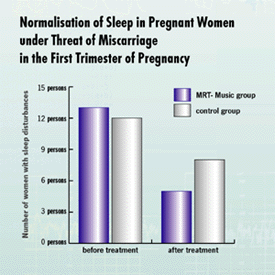The women were brought to the university hospital with great pains in the abdomen and ultrasound diagnoses showed that their pregnancy was at risk.
The reasons for the danger reached from environmentally caused stress situations over nervous mental tensions up to hormonal deficiencies.
On average the patients were 23 years old (±3,1). For seven of the women it was their first pregnancy, eight were pregnant for the second time.
Medical Resonance Therapy Music®
Group
For 8-10 days 15 patients received every day for 30-60 minutes a treatment with Medical Resonance Therapy Music® via compact disc and headphone and received no other treatment.
At the beginning of the treatment 13 out of 15 women in this group complained of sleep disturbances. At the end of the treatment sleep had normalized in 8 of them.
Control GroupFor 8-10 days 15 patients received every day for 30-60 minutes a treatment with Medical Resonance Therapy Music® via compact disc and headphone and received no other treatment.
At the beginning of the treatment 13 out of 15 women in this group complained of sleep disturbances. At the end of the treatment sleep had normalized in 8 of them.
In this group 15 women did not listen to MRT-Music® but received hormone drugs, sedatives, spasmolytica and physiotherapy.
At the beginning of the treatment 12 out of 15 women in this group complained of sleep disturbances. At the end of the treatment sleep had normalized in 4 of them.
Investigators:
Prof. Dr. med. G. Gerassimowitsch
Prof. Dr. med. Walentina Sidorenko
Dr. med. Swetlana Scheleg
Dr. med. Margarita Gawrisch
Dr. med. Tatjana Teterkina
Dr. med. Sergej Korotkow

